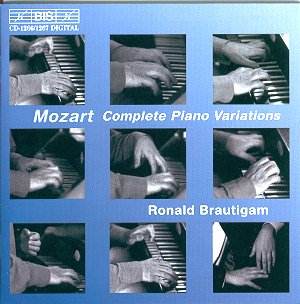Brautigam has already recorded the complete Mozart
sonatas (BIS-CD-835/837) and, as you can see, although this is called
"Complete Piano Variations" it actually slips in along the
way (the discs are arranged in listenable sequences, not as above) most
but not all of the miscellaneous pieces. I find this a little strange.
Having got this far Brautigam presumably wishes to finish recording
all Mozartís piano music and the pieces left over Ė a handful of sonata
allegros, a few minuets and a small number of odds and ends Ė hardly
amount to a full CD (it would be churlish, when this box is being offered
at 4 CDs for the price of 2, to suggest that there might have been room
for them here, for the timings are not all that long). So why not finish
the job then and there?
Compared with most recordings of the variations, this
includes K. Anh. 138a, usually known as part of the Sonata K. 547a (but
not included in Brautigamís sonata recordings). The very informative
booklet notes go into this in some detail, but not so much as to explain
why my Peters edition has an additional variation and a coda not played
here.
The instrument used was made in 1992 by Paul McNulty
in Amsterdam, following a model of Anton Gabriel Walter of c. 1795.
There are times when listening to a fortepiano provokes the irreverent
consideration that, were I to record a programme on my auntieís old
upright and palm it off as a fortepiano, no one would know the difference.
I think it is the richness of the harmonics which proclaim the present
as an instrument of very high quality (and it responds to recording
in a church as pianos almost never do). The many, many brilliant pieces
here have a really exciting sound, with something of a harpsichord ping
to the lower register, tempered with sweetness in the upper notes. Listen
to the two presto sections in the D minor Fantasia where rapid scales
cover the whole range of the keyboard to hear what a splendidly voiced
instrument this is (and what a splendidly even touch Brautigam has).
My notes are full of comments such as "a splendid display",
so once for all Iíll quote K. 613 as a set of variations which shows
pianist and instrument at their full-blooded best. (Note also the covered
tone obtained for the minor-key variation). No less effective are the
more delicate, musical-box sonorities of K. 573, while the chords of
the funeral march for Sig. Maestro Contrapunto are strikingly rich without
heaviness.
If I now have to make a few reservations, it should
be remembered that most of the music here is of a brilliant, virtuosic
nature and my reservations therefore regard a minority of the pieces.
Where grace is called for, as in the last part of the
D minor fantasia or the D major rondo, Brautigam remains obstinately
firm toned and rather heavy. By the same token K. 455 is somewhat perfunctory.
One of the advantages of the fortepiano over the piano is supposed to
be that chords from the middle register down donít sound clumpy. Unfortunately
the accompaniment to the principal theme of the A minor rondo shows
that they do if the pianist does nothing to unclump them (whereas Rubinstein
with his modern Steinway reduces his accompaniment to a gentle pulsation).
A melody line tied down by an obtrusively chugging accompaniment tends
to be a liability in slow pieces and variations. I noticed this first
in the 11th variation of K. 353, and the Adagio in B minor
is a long haul indeed. Brautigam seems to find it difficult to liberate
his melodies from their accompaniments as we are told Mozart himself
did, though to be fair I did make a note that he managed to voice the
different layers of texture very successfully in the slow variation
of K. 264. I also noted in the freer variations of K. 613 a degree of
spontaneity which is not always present elsewhere.
So what does this add up to? Brautigamís brilliance
and enthusiasm, as well as the instrument itself, are just what is needed
most of the time. Perhaps he will now record some of the concertos and
seek out that depth and spontaneity which he seems capable of, but does
not yet have completely on tap, as it were.
Christopher Howell

![]() Ronald Brautigam (fortepiano)
Ronald Brautigam (fortepiano)
![]() BIS CD-1266/1267 [4
CDs: 60.37, 63.07, 61.37, 61.21]
BIS CD-1266/1267 [4
CDs: 60.37, 63.07, 61.37, 61.21]